Chapter 18.35
DEFINITIONS
Sections:
18.35.010 “A” terms.
“Abutting” means having a common boundary.
“Access” means the place or way through which pedestrians and/or vehicles have safe, adequate, and usable ingress and egress to a property or use.
Accessory Building. See “Building, accessory.”
Accessory Structure. See “Structure, accessory.”
Accessory Use. See “Use, accessory.”
“Adjacent” means directly abutting, having a common boundary or property line, or contiguous to.
Adjoining. See “Abutting.”
“Agent” or “authorized agent” means any person who can show certified written proof that they are representing and acting in the place of another person or individual.
“Aggrieved person” means any person who, in person or through a representative, appeared at a City public hearing in conjunction with a decision or action appealed or who, by other appropriate means prior to a hearing, informed the local government of the nature of his or her concerns or who, for good cause, was unable to do either.
“Alley” means a public or private way, other than a street, which is designated as an alley by the City, reserved primarily for secondary vehicular access to abutting lots.
“Alteration” means any change, addition, or modification that changes the exterior architectural appearance or materials of a structure or object. “Alteration” includes changes in exterior surfaces, changes in materials, additions, remodels, demolitions, and relocation of buildings or structures, but excludes ordinary maintenance and repairs.
“Applicant” means the person, partnership, corporation, or State or local government agency applying for a permit, certificate, zoning approval, or other entitlement.
“Architectural feature” means an exterior building feature, including a roof, walls, windows, doors, porches, posts, pillars, recesses or projections, and exterior articulation or walls, and other building surfaces.
“Assessed value” means the value as shown on the current equalized assessment roll in effect at the time of the making of the determination of the assessed value.
“Assessor” means the Tax Assessor of the County of Solano.
Attached Building or Structure. See “Building, attached” and “Structure, attached.”
“Awning” means a roof-like cover that projects from the wall of a building for the purpose of shielding a doorway or window from the elements. [Ord. 24-002 § 5 (Exh. A).]
18.35.020 “B” terms.
“Balcony” means a platform that projects from the wall of a building thirty (30) inches or more above grade that is accessible from the building’s interior, is not accessible from the ground, and is not enclosed by walls on more than three (3) sides.
“Basement” means the portion of building between the floor and ceiling which has more than fifty percent (50%) below the natural or finished grade of the exterior ground surface.
“Bedroom” means any room meeting the standards of the building code as a sleeping room.
“Block” means all property fronting on one (1) side of a street and lying between the two (2) nearest intersecting or intercepting streets, or nearest intersecting or intercepting street and railroad right-of-way, undivided land or watercourse.
“Buffer” means an open area or barrier used to separate potentially incompatible activities and/or development features.
“Building” means any structure having a roof supported by columns or walls and intended for the shelter, housing, or enclosure of persons, animals or property of any kind.
1. “Building, accessory” means a detached, subordinate building used only as incidental to the main building or structure, or principal use on the same lot.
2. “Building, attached” means a building which has a four (4) or more linear feet of common wall or roof with another building or structure that is four (4) feet in length or more.
3. “Building, detached” means a building which does not have a common wall or roof with another building or structure or whose common wall or roof with another building is less than four (4) feet in length.
4. “Building, main” means a building in which a principal use of the parcel on which it is located is conducted.
5. “Building, nonconforming” means a building, or portion thereof, which was lawfully erected or altered or maintained, but which, because of the application of this zoning code to it, no longer conforms to the regulations set forth in this zoning code.
“Building code” means any ordinance or regulations of the City governing the type and method of construction of buildings and structures, including sign structures, and any amendments thereto and any substitute therefor, including, but not limited to, the California Building Code and other State-adopted uniform codes.
“Building face” means the general outer surface of the structure or walls of a building.
Building Footprint. See “Footprint.”
Building Frontage. See “Frontage, building.”
Building Height. See “Height.”
“Building site” means a lot or parcel of land occupied or to be occupied by a building or group of buildings. [Ord. 24-002 § 5 (Exh. A).]
18.35.030 “C” terms.
“California Environmental Quality Act (CEQA)” means Cal. Pub. Res. Code § 21000 et seq. or any successor statute and regulations promulgated thereto (14 Cal. Code of Regulations § 15000 et seq.) that require public agencies to document and consider the environmental effects of a proposed action before a decision.
“Camper” means as defined in the California Vehicle Code.
“Canopy” means a roofed shelter projecting over a sidewalk, driveway, entry, window, or similar area that may be wholly supported by a building or may be wholly or partially supported by columns, poles, or braces extending from the ground.
“Carport” means an accessible and usable covered space enclosed on not more than two (2) sides, designed, constructed, and maintained for the parking or storage of one (1) or more motor vehicles.
“Change of use” means the replacement of an existing use on a site, or any portion of a site, by a new use, or a change in the type of an existing use; does not include a change of ownership, tenancy, or management associated with a use for which the previous type of use will remain substantially unchanged.
“City” means the City of Dixon.
“City Council” means the City Council of the City of Dixon.
“Clerk” means the City Clerk of the City of Dixon.
Commission. See “Planning Commission.”
“Common area” means the entire project area, excepting all units or areas granted or reserved for the exclusive occupancy of a tenant and/or condominium unit owner.
“Community apartment project” means development of real property in which an undivided interest in the land is coupled with the right to the exclusive occupancy of a designated apartment located thereon and which is legally defined by applicable State law.
“Community Development Department” means the Community Development Department of the City of Dixon.
“Community Development Director” means the Community Development Director of the City of Dixon or their designee.
“Compatible” means that which is harmonious with and will not adversely affect surrounding buildings and/or uses.
“Condition of approval” means a performance standard, required change in a project, environmental mitigation measure, or other requirement imposed by the decision-making body to alter or modify a project in any manner from the description in the application originally submitted for City approval.
“Conditional use” means a use that is generally compatible with other permitted uses, but that requires individual review of its location, design, configuration, and intensity and density of use and structures, and may require the imposition of conditions pertinent thereto to ensure the appropriateness of the use at that location.
“Conditionally permitted” means permitted subject to approval of a use permit.
“Condominium” means a building or group of buildings in which units are owned individually and the structure, common areas, and facilities are owned by all the owners on a proportional, undivided basis and which is legally defined by applicable State law.
“County” means the County of Solano. [Ord. 24-002 § 5 (Exh. A).]
18.35.040 “D” terms.
“Deck” means a platform, either freestanding or attached to a building, that is supported by pillars or posts.
“Density” means the number of dwelling units per acre of land.
Detached Building. “See Building, detached.”
Detached Structure. “See Structure, detached.”
“Development” means any manmade change to improved or unimproved real estate, including but not limited to the division of a parcel of land into two (2) or more parcels; the construction, reconstruction, conversion, structural alteration, relocation, or enlargement of any structure; any mining, excavation, landfill or land disturbance; and any use or extension of the use of land.
“Development agreement” means an agreement between the City and any person having a legal or equitable interest in real property for the development of such property, and which complies with the applicable provisions of the Government Code for such development agreements.
“Director” means the Community Development Director of the City of Dixon or their designee.
District. See “Zoning district.”
“Driveway” means an accessway that provides direct vehicular access for vehicles between a street and the parking or loading facilities located on an adjacent property.
“Dwelling unit” means one (1) or more rooms designed, occupied, or intended for occupancy as separate living quarters, with full cooking, sleeping, and bathroom facilities for the exclusive use of a single household. [Ord. 24-002 § 5 (Exh. A).]
18.35.050 “E” terms.
“Easement” means a portion of land created by grant or agreement for specific purpose; an easement is the right, privilege or interest which one (1) party has in the land of another.
“Effective date” means the date on which a permit or other approval becomes enforceable or otherwise takes effect, rather than the date it was signed or circulated.
“Electrical code” means any ordinance of the City regulating the alteration, repair, and the installation and use of electricity or electrical fixtures.
“Emergency” means a sudden unexpected occurrence demanding immediate action to prevent or mitigate loss or damage to life, health, property, or essential public services.
“Emergency vehicle” means a self-propelled vehicle or trailer used in the discharge of duties of public districts, agencies or departments, or privately owned public utilities responsible for fire prevention and control, policing, sanitation, sewerage, drainage, levee maintenance, flood control, public utility lines and all essential services.
“Environmental impact report (EIR)” means an environmental impact report as required under the California Environmental Quality Act (CEQA).
“Environmental review” means an evaluation process pursuant to CEQA to determine whether a proposed project may have a significant impact on the environment.
“Equipment” means nonvehicular items such as, but not limited to, boats, campers, camper shells, tents and related camping supplies, tools, machinery, aircraft, barrels, drums, large cans or containers and parts related to these items.
“Erect” means to build, construct, attach, hang, place, suspend, or affix to or upon any surface. Such term also includes the painting of wall signs.
“Explosives” means any explosive substance as defined in Cal. Health & Safety Code § 12000. [Ord. 24-002 § 5 (Exh. A).]
18.35.060 “F” terms.
“Facade” means the exterior wall of a building exposed to public view or that wall viewed by persons not within the building.
“Family” means one (1) or more persons living together in a single household unit, with common access to, and common use of, all living and eating areas and all areas and facilities for the preparation and storage of food; who share living expenses, including rent or mortgage payments, food costs and utilities, and who maintain a single mortgage, lease, or rental agreement for all members of the household.
“Feasible” means capable of being accomplished in a successful manner within a reasonable period of time, taking into account economic, environmental, social, and technological factors.
“Fence” means any horizontal or vertical structural device forming a physical barrier intended to enclose areas, separate properties, form a screen, or prevent intrusion.
“Floor area” means the total horizontal area of all floors below the roof and within the outer surface of the walls of a building or other enclosed structure unless otherwise stipulated. See also DMC 18.02.030(E), Determining Floor Area.
“Floor area ratio (FAR)” means the ratio of the total floor area of all buildings on a lot to the lot area or building site area. See also DMC 18.02.030(F), Determining Floor Area Ratio.
“Foot-candle” means a quantitative unit of measure for luminance. One (1) foot-candle is equal to the amount of light generated by one (1) candle shining on one (1) square foot surface located one (1) foot away. It is equal to one (1) lumen uniformly distributed over an area of one (1) square foot.
“Footprint” means the horizontal area, as seen in plan view, of a building or structure, measured from the outside of exterior walls and supporting columns, and excluding eaves. See also DMC 18.02.030(G), Determining Lot Coverage.
“Freeway” means a multilane State or interstate highway for through traffic with full control of access and with grade separations at all intersections and railroad crossings, and to which highway the owners of abutting lands have no right of easement or access to or from their abutting lands.
“Frontage, building” means the face of a building that is parallel to or is at a near-parallel angle to a street.
“Frontage, street” means that portion of a lot or parcel of land that borders a street. Street frontage shall be measured along the common lot line separating said lot or parcel of land from the street, highway, or parkway. [Ord. 24-002 § 5 (Exh. A).]
18.35.070 “G” terms.
“Garage” means an accessory structure or portion of a main structure, enclosed on all sides and containing accessible and usable enclosed space designed, constructed, and maintained for the parking and storage of one (1) or more motor vehicles.
“General Plan” means the General Plan of the City of Dixon.
“Glare” means the effect produced by a light source within the visual field that is sufficiently brighter than the level to which the eyes are adapted, such as to cause annoyance, discomfort, or loss of visual performance and ability.
“Government Code” means the Government Code of the State of California.
“Grade” means the location of the ground surface.
1. “Grade, existing or natural” means ground elevation prior to any grading or other site preparation related to, or to be incorporated into, a proposed development or alteration of an existing development.
2. “Grade, finished” means final ground elevation after the completion of any grading or other site preparation related to, or to be incorporated into, a proposed development or alteration of an existing development.
“Grading” means any stripping, cutting, filling, or stockpiling of earth or land, including the land in its cut or filled condition.
“Ground floor” means the first floor of a building other than a basement that is closest to finished grade. [Ord. 24-002 § 5 (Exh. A).]
18.35.080 “H” terms.
“Hazardous materials” means any material, including any substance, waste, or combination thereof, which because of its quantity, concentration, or physical, chemical, or infectious characteristics may cause, or significantly contribute to, a substantial present or potential hazard to human health, safety, property, or the environment when improperly treated, stored, transported, disposed of, or otherwise managed.
“Heat” means thermal energy of a radioactive, conductive, or convective nature.
“Height” means the vertical distance from a point on the ground below a structure to a point directly above. See also DMC 18.02.030(C), Measuring Height.
“Home occupation” means a commercial use conducted on residential property by the inhabitants of the subject residence, which is incidental and secondary to the residential use of the dwelling.
Household. See “Family.” [Ord. 24-002 § 5 (Exh. A).]
18.35.090 “I” terms.
“Illegal use” means any use of land or building that does not have the currently required permits, and was originally constructed and/or established without permits or approvals required for the use at the time it was brought into existence.
Impervious Surface. Impervious surfaces are mainly artificial structures such as pavements (roads, sidewalks, driveways and parking lots, as well as industrial areas such as airports, ports and logistics and distribution centers) that are covered by impenetrable materials such as asphalt, concrete, brick, stone, etc.
“Improvement” means an object affixed to the ground other than a structure.
Incidental Use. See “Use, incidental.”
“Intensity of use” means the extent to which a use or the use in combination with other uses affects the natural and built environment in which it is located; the demand for services; and persons who live, work, and visit the area. Measures of intensity include, without limitation: requirements for water, gas, electricity, or public services; number of automobile trips generated by a use; parking demand; number of employees on a site; hours of operation; the amount of noise, light, or glare generated; the number of persons attracted to the site or, in eating establishments, the number of seats.
“Intersection, street” means the area common to two (2) or more intersecting streets. [Ord. 24-002 § 5 (Exh. A).]
18.35.100 “J” terms.
Reserved. [Ord. 24-002 § 5 (Exh. A).]
18.35.110 “K” terms.
“Kitchen” means any room or space within a building intended to be used for the cooking or preparation of food. [Ord. 24-002 § 5 (Exh. A).]
18.35.120 “L” terms.
“Land use” means the purpose for which land or a structure is designed, arranged, intended, occupied, or maintained, including residential, commercial, industrial, etc.
“Landscaping” means the planting, configuration, and maintenance of trees, ground cover, shrubbery, and other plant material, decorative natural and structural features (walls, fences, hedges, trellises, fountains, sculptures), earth-patterning and bedding materials, and other similar site improvements that serve an aesthetic or functional purpose.
“Light fixture” means the assembly that holds a lamp and may include an assembly housing, a mounting bracket or pole socket, a lamp holder, a ballast, a reflector or mirrors, and a refractor or lens.
“Living area” means the legally permitted interior area of a dwelling unit, with the exception of a garage or any accessory structure, including basements and attics which meet the habitability requirements of the building code.
“Lot” means a parcel, tract, or area of land whose boundaries have been established by a legal instrument, such as a deed or recorded map recorded, and which is recognized as a separate legal entity for purposes of transfer of title, except public easements or rights-of-way. Lot types include the following:
1. “Abutting lot” means lot having a common property line or separated by a public path or lane, private street, or easement to the subject lot.
2. “Corner lot” means a lot or parcel bounded by two (2) or more adjacent street lines that have an angle of intersection of not more than one hundred thirty-five (135) degrees.
3. Double Frontage Lot. See “Through lot.”
4. “Flag lot” means a lot so shaped that the main portion of the lot area does not have access to a street other than by means of a corridor having less than twenty (20) feet of width.
5. “Interior lot” means a lot other than a corner lot or reversed corner lot.
6. “Key lot” means an interior lot adjoining the rear lot line of a reversed corner lot, whether or not separated by an alley.
7. “Reversed corner lot” means a corner lot, the side street line of which is substantially a continuation of a front lot line of the lot upon which the rear of said corner lot abuts.
8. “Through lot” means a lot having frontage on two (2) parallel or approximately parallel streets.
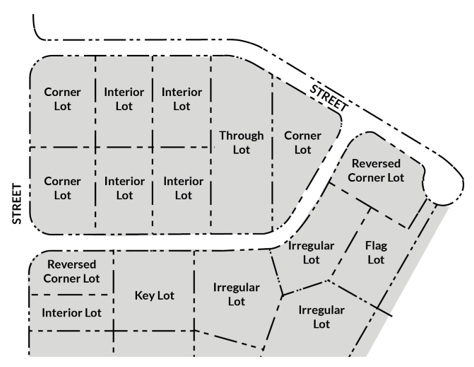
FIGURE 18.35.120.A: LOT TYPES
“Lot area” means the area of a lot measured horizontally between bounding lot lines.
“Lot coverage” means the portion of a lot that is covered by structures, including main and accessory buildings, garages, carports, and roofed porches, but not including unenclosed and unroofed decks, landings, or balconies. See also DMC 18.02.030(G), Determining Lot Coverage.
“Lot depth” means the horizontal distance between the front and rear property lines of a site. See also DMC 18.02.030(D), Measuring Lot Width and Depth.
Lot Frontage. See “Frontage, street.”
“Lot line” means the boundary between a lot and other property or the public right-of-way.
1. “Front lot line” means, on an interior lot, the line separating the lot from the street. On a corner lot, the shorter lot line abutting a street. On a through lot, the lot line abutting the street providing the primary access to the lot. On a flag lot, the interior lot line most parallel to and nearest the street from which access is obtained.
2. “Corner side lot line” means a side lot line of a corner lot that is adjacent to a street.
3. “Interior lot line” means any lot line that is not adjacent to a street.
4. “Rear lot line” means the lot line that is opposite and most distant from the front lot line. Where no lot line is within forty-five (45) degrees of being parallel to the front lot line, a line ten (10) feet in length within the lot, parallel to and at the maximum possible distance from the front lot line, will be deemed the rear lot line for establishing the minimum rear setback.
5. “Side lot line” means any lot line that is not a front or rear lot line.
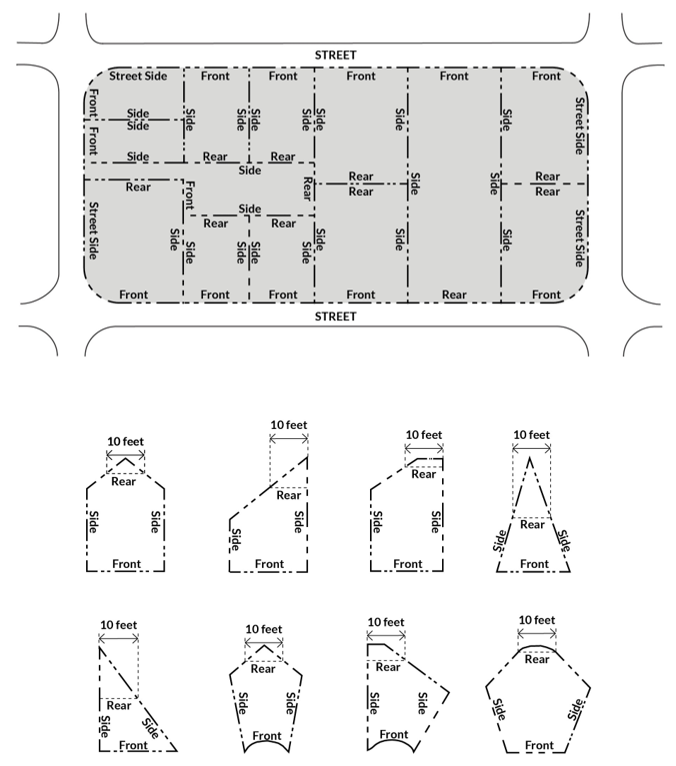
FIGURE 18.35.120.B: LOT LINE TYPES
“Lot, nonconforming” means legal parcel of land having less area, frontage, or dimensions than required in the zoning district in which it is located.
“Lot width” means the average distance between the side lot lines measured at right angles to the lot depth. See also DMC 18.02.030(D), Measuring Lot Width and Depth. When not applicable due to irregularity of lot shape, lot width shall be determined by the Director. [Ord. 24-002 § 5 (Exh. A).]
18.35.130 “M” terms.
“Maintenance and repair” means the repair or replacement of nonbearing walls, fixtures, wiring, roof, or plumbing that restores the character, scope, size, or design of a structure to its previously existing, authorized, and undamaged condition.
“Mobile home” means a structure transportable in one (1) or more sections, and which is built on a permanent chassis, and designed to be used as a dwelling unit.
“Municipal code” means the City of Dixon Municipal Code. [Ord. 24-002 § 5 (Exh. A).]
18.35.140 “N” terms.
“Noise” means any sound that annoys or disturbs humans or which causes or tends to cause an adverse psychological or physiological effect on humans.
Nonconforming Building. See “Building, nonconforming.”
Nonconforming Lot. See “Lot, nonconforming.”
Nonconforming Structure. See “Structure, nonconforming.”
Nonconforming Use. See “Use, nonconforming.” [Ord. 24-002 § 5 (Exh. A).]
18.35.150 “O” terms.
“On site” means located on the lot that is the subject of discussion.
“Outdoor storage” means the keeping, in an unroofed area, of any goods, junk, material, merchandise, or vehicles in the same place for more than seventy-two (72) hours, except for the keeping of building materials reasonably required for construction work on the premises pursuant to a valid and current building permit issued by the City.
“Owner” means a person or persons holding single or unified beneficial title to the property, including without limitation, the settlor of a grantor trust, a general partner, firm, or corporation. [Ord. 24-002 § 5 (Exh. A).]
18.35.160 “P” terms.
“Parapet” means that part of a wall that extends above the roof line.
“Parking area” means an area of a lot, structure, or any other area, including driveways, which is designed for and the primary purpose of which is to provide for the temporary storage of operable motor vehicles.
“Passenger vehicle” means as defined in the California Vehicle Code.
Permitted Use. See “Use, permitted.”
“Person” means any individual, firm, association, organization, partnership, business trust, company, or corporation.
“Planning Commission” means the Planning Commission of the City of Dixon.
“Preexisting” means in existence prior to the effective date of this zoning code.
Principal Use. See “Use, principal.”
“Project” means any proposal for a new or changed use or for new construction, alteration, or enlargement of any structure that is subject to the provisions of this zoning code. This term includes, but is not limited to, any action that qualifies as a “project” as defined by the California Environmental Quality Act.
“Property line” means the recorded boundary of a lot or parcel of land.
“Public Resources Code” means the Public Resources Code of the State of California.
“Public Works Director” means the Public Works Director of the City of Dixon. [Ord. 24-002 § 5 (Exh. A).]
18.35.170 “Q” terms.
“Qualified applicant” means the property owner, the owner’s agent, or any person, corporation, partnership, or other legal entity that has a legal or equitable title to land that is the subject of a development proposal or is the holder of an option or contract to purchase such land, or otherwise has an enforceable proprietary interest in such land. [Ord. 24-002 § 5 (Exh. A).]
18.35.180 “R” terms.
“Reasonable accommodation” means any deviation requested and/or granted from the strict application of the City’s zoning and land use laws, rules, policies, practices and/or procedures under provisions of Federal or California law to make housing or other facilities readily accessible to and usable by persons with disabilities and thus enjoy equal employment or housing opportunities or other benefits guaranteed by law.
“Review authority” means the body or entity responsible for making decisions on applications.
“Right-of-way” means a strip of land acquired by reservation, dedication, forced dedication, prescription or condemnation and intended to be occupied or occupied by a road, railroad, electric transmission lines, oil or gas pipeline, water line, sanitary storm sewer, or other similar use.
“Roofline” means the top edge of a roof or building parapet, whichever is higher, excluding any cupolas, pylons, chimneys, or minor projections. [Ord. 24-002 § 5 (Exh. A).]
18.35.190 “S” terms.
“Senior citizen” means an individual sixty-two (62) years of age or older.
“Setback” means the distance between a property line and a building or structure that must be kept unoccupied and unobstructed from the ground upward, except as otherwise provided by this zoning code.
1. “Front setback” means a setback area extending across the front of a lot for the full width of the lot between the side lot lines. The depth of a front setback shall be a distance specified by this zoning code for the zoning district in which it is located and measured inward from the front lot line.
2. “Interior setback” means a setback which does not abut a street.
3. “Interior side setback” means a setback area extending from the rear line of the required front setback, or the front property line of the site where no front setback is required, to the front line of the required rear setback, or the rear property line of the site where no rear setback is required, the depth of which is the minimum horizontal distance between the side property line and a line parallel thereto on the site and which does not abut a street.
4. “Rear setback” means a setback area extending across the rear of a lot for its full width between side lot lines, and to a depth specified by this zoning code for the zoning district in which it is located. If a lot has no rear lot line, a line ten (10) feet in length within the lot, parallel to and at the maximum possible distance from the front lot line, will be deemed the rear lot line for establishing the minimum rear setback.
5. “Required setback” means a setback area which complies with the minimum setback requirements for the zoning district in which the lot is located.
6. “Side setback” means a setback area extending from the rear line of the required front setback, or the front property line of the site where no front setback is required, to the front line of the required rear setback, or the rear property line of the site where no rear setback is required, the depth of which is the minimum horizontal distance between the side property line and a line parallel thereto on the site.
7. “Street side setback” means a setback area on a corner lot or reversed corner lot extending from the front setback to the rear lot line between the building setback line and the nearest side street lot line.
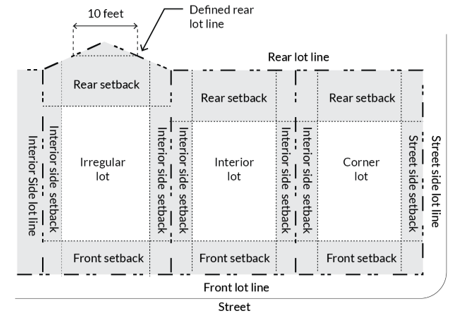
FIGURE 18.35.190.A: SETBACK TYPES
“Sidewalk” means a paved, surfaced, or leveled area, paralleling and usually separated from the street, used as a pedestrian walkway.
Sign Terms.
1. “A-frame sign” means a portable, upright, rigid, self-supporting frame sign in the form of a triangle or letter “A.”
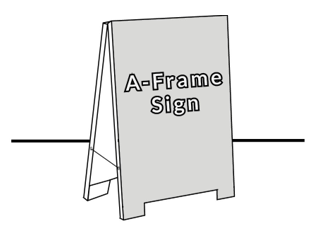
FIGURE 18.35.190.B: A-FRAME SIGN
2. “Animated sign” means a sign with messages that visually change, or images that move or appear to move, flash on or off, wink or blink with varying light intensity, show motion or create the illusion of motion, or revolve to create an illusion of being on or off.
3. “Awning sign” means a sign placed on an awning.
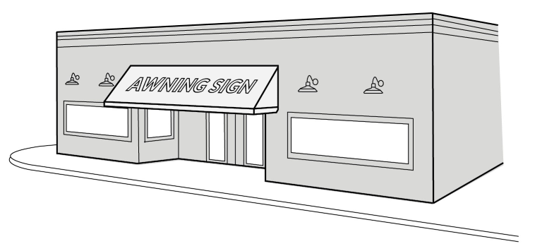
FIGURE 18.35.190.C: AWNING SIGN
4. “Balloon” means any air- or gas-filled device used for the purposes of signage or advertising.
5. “Banner sign” means a sign that is painted or printed on lightweight flexible material and hung from a staff or other device by ropes, wires or similar means in a manner to minimize movement.
6. “Billboard” means a sign used for the purpose of general advertising for hire; that is, some or all of the display area is customarily used to display the messages of advertisers or sponsors other than the owner of the sign.
7. “Canopy sign” means a sign placed on a canopy.
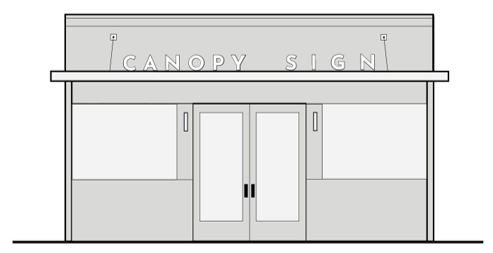
FIGURE 18.35.190.D: CANOPY SIGN
8. “Commercial message” means a message on a sign, or portion of a sign, that promotes, informs, or proposes an economic transaction, primarily concerns the economic interests of the sign sponsor and/or audience, or is intended to further discussion in the marketplace of goods and services.
9. “Copy,” also called “sign copy,” means the visually communicative elements mounted on a sign.
10. “Digital display” means a method of displaying a communicative visual image by use of LEDs (light emitting diodes) or their functional equivalent, that allows for the message or image to be easily changed, typically by remote control or computer programming. This definition applies to signs displaying a series of still images, as well as those presenting the appearance of motion.
11. “Directional sign” means a sign that directs or guides pedestrian or vehicular traffic and which is nonadvertising in nature (e.g., handicapped parking, one-way, exit, and entrance).
12. “Electronic message center sign” means a sign with a static message formed by the selective illumination of an array of light bulbs, light emitting diodes (LEDs), or liquid crystal displays (LCDs) that can be changed electronically. These signs may display text and/or graphic images, and may be programmable.
13. “Flag” means any fabric or banner containing distinctive colors, patterns, or design that displays the symbol(s) of a nation, state, local government, company, organization, belief system, idea, or other meaning.
14. “Freestanding sign” means a sign supported by structures or supports that are placed on or anchored in the ground, and which are structurally independent from any building.
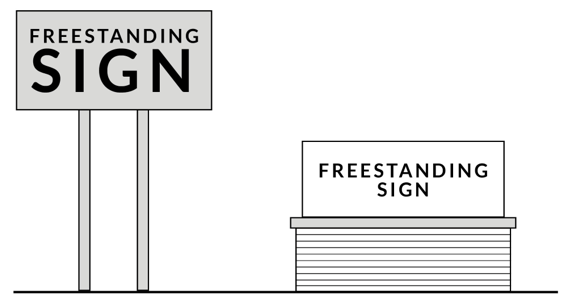
FIGURE 18.35.190.E: FREESTANDING SIGN
15. “Freeway-oriented sign” means a freestanding sign erected or maintained to advertise off-site goods and services to motorists traveling on Interstate 80 that has no electronic components.
16. “Freeway-oriented sign, multi-tenant” means a freestanding sign located in a regional commercial district erected or maintained to advertise goods and services to motorists.
17. “General advertising for hire” means the advertising or promoting of other businesses, establishments or causes using methods of advertising, typically for a fee or other consideration, in contrast to self-promotion or on-site advertising.
18. “Graffiti” means marks, such as inscriptions, drawings, or designs, which are placed, scratched, etched, painted, or sprayed on public or private property without the owner’s consent.
19. “Illuminated sign” means a sign with an artificial source of light incorporated internally or externally for the purpose of illuminating the sign.
20. “Inflatable sign” means a form of inflatable device (e.g., shaped as an animal, blimp, or other object) that is displayed, printed, or painted on the surface of an inflatable background, and is primarily installed outside a building to attract attention to or to advertise a business, a business location, a service, a product, or an event.
21. “Internally illuminated sign” means a sign that is illuminated by a light source that is contained inside the sign where the message area is luminous, including cabinet signs and channel-letter signs.
22. “Mobile billboard” means any vehicle or wheeled conveyance which carries, conveys, pulls, displays, or transports any sign or billboard for the primary purpose of advertising a commercial or noncommercial message, or other general advertising for hire.
23. “Moving sign” means a sign or any portion thereof that rotates, moves, or appears to move in some manner by mechanical, electrical, natural, or other means.
24. “Noncommercial message” means a message or image on a sign that directs public attention to or advocates an idea or issue of public interest or concern that does not serve to advertise or promote any business, product, activity, service, interest, or entertainment.
25. “Nonconforming sign” means a sign lawfully erected and legally existing on the effective date of the ordinance codified in this title, but which does not conform to the provisions of this title.
26. “Outdoor advertising structure” means any structure of any kind or character erected or maintained for outdoor advertising purposes, upon which any outdoor advertising sign may be placed, located on a site other than the site on which the advertised use is located or on which the advertised product is produced.
27. “Pennant” means a device made of flexible materials (e.g., cloth, paper, or plastic) that may or may not contain copy, and which is installed for the purpose of attracting attention.
28. “Permanent sign” means a sign that is intended to be and is so constructed as to be of a lasting and enduring condition, remaining unchanged in character, condition (beyond normal wear) and position, and in a permanent manner affixed to the ground, wall, or building.
29. “Projecting sign” means a sign that projects horizontally from the face of a building.
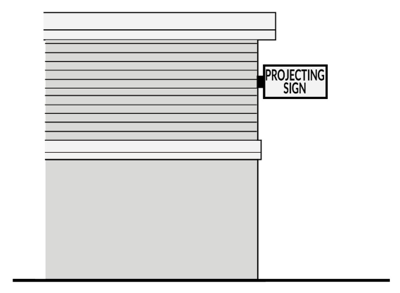
FIGURE 18.35.190.F: PROJECTING SIGN
30. “Roof sign” means any sign located on a roof of a building or having its major structural supports attached to a roof that extend above the roofline or parapet.
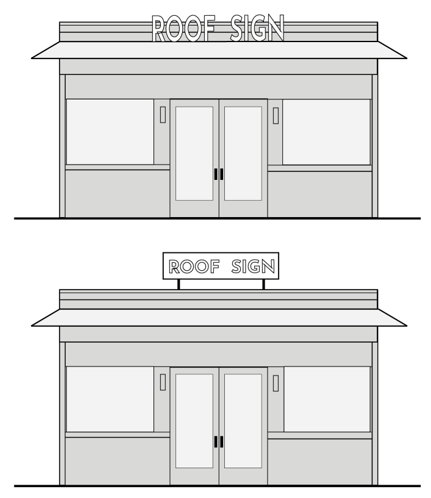
FIGURE 18.35.190.G: ROOF SIGN
31. “Shingle sign” means a sign that is suspended beneath a marquee, covered walkway, canopy, or awning.

FIGURE 18.35.190.H: SHINGLE SIGN
32. “Sign” means any identification, description, illustration, or device, illuminated or nonilluminated, which is visible to the general public from any exterior public right-of-way, and directs attention to a product, service, place, activity, person, institution, business or solicitation, including any permanently installed or situated merchandise; or any emblem, painting, banner, pennant, or placard designed to advertise, identify, or convey information. A display, device, or thing need not contain lettering to be a sign.
33. “Sign area” means the area contained within a single continuous perimeter enclosing all parts of such sign copy, excluding any structural elements outside the limits of the sign required to support the sign.
34. “Sign face” means an exterior display surface of a sign, including nonstructural trim, exclusive of the supporting structure. The area of a sign which is available for mounting and public display of the visually communicative image.
35. “Temporary sign” means a structure or device used for the public display of visual messages or images, which is typically made of lightweight or flimsy materials which is not intended for or suitable for long term or permanent display.
36. “Traffic sign” means a sign for traffic direction, warning, and roadway identification.
37. “Wall sign” means a sign affixed to and wholly supported by a building in such a manner that its exposed face is approximately parallel to the plane of such building.

FIGURE 18.35.190.I: WALL SIGN
38. “Window sign” means a temporary or permanent sign with a single face of copy that is painted or installed on a glass window or door, or located within twelve (12) inches from inside the window, in a manner that it can be viewed from the exterior of a structure.
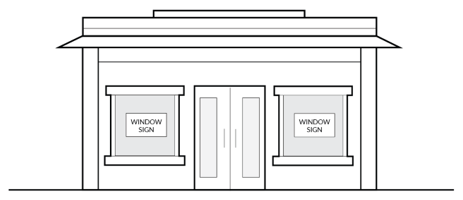
FIGURE 18.35.190.J: WINDOW SIGN
“Site” means a lot, or group of contiguous lots, that is proposed for development in accordance with the provisions of this zoning code and is in a single ownership or under unified control.
“Soil” means naturally occurring superficial deposits overlying bedrock.
“Solar reflectance index” means the measure of a surface’s ability to reflect solar heat, combining reflectance and emittance into one (1) number. It is defined so that a standard black (reflectance 0.05, emittance 0.90) is zero (0) and a standard white (reflectance 0.80, emittance 0.90) is one hundred (100).
“Specific plan” means a plan for all or part of the area covered by the General Plan that is prepared to be consistent with and to implement the General Plan, pursuant to the provisions of Cal. Gov’t Code § 65450 et seq.
“State” means the State of California.
“Story” means that portion of a building included between the upper surface of any floor and the upper surface of the floor next above, except that the topmost story is that portion of a building included between the upper surface of the topmost floor and the upper surface of the roof above.
“Street” means a public or private thoroughfare, which affords the principal means of access to a block and to abutting property. “Street” includes avenue, court, circle, crescent, place, way, drive, boulevard, highway, road, and any other thoroughfare, except an alley or walkway.
“Street line” means the boundary between a street and a lot or parcel of land.
“Structure” means anything constructed or erected which requires a location on the ground, including a building but not including a swimming pool, a fence, or a wall used as a fence.
1. “Structure, accessory” means a detached subordinate structure used only as incidental to a main building or structure, or principal use on the same site or lot.
2. “Structure, attached” means a structure which is affixed to another building or structure on the site with a common wall or roof that is four (4) feet in length or more.
3. “Structure, detached” means a structure which is not affixed to another building or structure on the site or whose common wall or roof with another building or structure is less than four (4) feet in length.
4. “Structure, nonconforming” means a building or structure, or portion thereof, which was lawfully erected or altered or maintained, but which, because of the application of this zoning code to it, no longer conforms to the regulations set forth in this zoning code.
5. “Structure, main” means a structure housing the primary or principal use of a site or functioning as the primary or principal use.
6. “Structure, temporary” means a structure without any foundation or footings, and which is intended to be removed when the designated time period, activity, or use for which the temporary structure was erected has ceased.
“Swimming pool” means a pool, pond, lake, or open tank capable of containing water to a depth greater than eighteen (18) inches at any point. [Ord. 24-002 § 5 (Exh. A).]
18.35.200 “T” terms.
“Tandem parking” means an arrangement of parking spaces such that one (1) or more spaces must be driven across to access another space or spaces.
“Tenant” means a person renting or leasing a housing unit or nonresidential space.
“Trailer” means a vehicle with or without motor power, which is designed or used for hauling materials or vehicles, or for human habitation, office, or storage including camper, recreational vehicle, travel trailer, and mobile home, but not including mobile homes on a permanent foundation. [Ord. 24-002 § 5 (Exh. A).]
18.35.210 “U” terms.
“Use” means the purpose for which a site or structure is arranged, designed, intended, constructed, erected, moved, altered, or enlarged or for which either a site or a structure is or may be occupied or maintained.
1. “Use, accessory” means a use that is customarily associated with, and is incidental and subordinate to, a principal use and located on the same lot as a principal use.
2. “Use, incidental” means a secondary use of a lot and/or building that is located on the same lot, but is not customarily associated with the principal use.
3. “Use, nonconforming” means the use of a building, structure, site, or portion thereof, which was lawfully established and maintained, but which, because of the adoption and application of this zoning code, no longer conforms to the specific regulations applicable to the zone in which it is located.
4. “Use, permitted” means any use or structure that is allowed in a zone without a requirement for approval of a use permit, but subject to any restrictions applicable to that zone.
5. “Use, principal” means primary, principal, or dominant use established, or proposed to be established, on a lot.
“Use classification” means a system of classifying uses into a limited number of use types on the basis of common functional, product, or compatibility characteristics. All use types are grouped into the following categories: residential, public/semi-public, commercial, industrial, and transportation, communication, and utilities. See Chapter 18.34 DMC, Use Classifications.
“Use permit” means a discretionary permit which may be granted by the appropriate City of Dixon authority to provide for the accommodation of land uses with special site or design requirements, operating characteristics, or potential adverse effects on surroundings, which are not permitted as of right, but which may be approved upon completion of a review process and, where necessary, the imposition of special conditions of approval. See Chapter 18.24 DMC, Use Permits.
“Use type” means a category that classifies similar uses based on common functional, product, or compatibility characteristics.
“Utilities” means equipment and associated features related to the mechanical functions of a building(s) and services such as water, electrical, telecommunications, and waste. [Ord. 24-002 § 5 (Exh. A).]
18.35.220 “V” terms.
“Variance” means a discretionary grant of permission to depart from the specific requirements of this zoning code that is warranted when, due to special circumstances regarding the physical characteristics of the property, the strict application of standards would deprive the property of privileges available to other property in the same zone.
“Vehicle” means any vehicle, as defined by the California Vehicle Code, including any automobile, camper, camp trailer, trailer, trailer coach, motorcycle, house car, boat, or similar conveyance.
“Vibration” means a periodic motion of the particles of an elastic body or medium in alternately opposite directions from the position of equilibrium.
“Visible” means capable of being seen (whether legible) by a person of normal height and visual acuity walking or driving on a public road or in a public place. [Ord. 24-002 § 5 (Exh. A).]
18.35.230 “W” terms.
“Wall” means any vertical exterior surface of building or any part thereof, including windows.
Wireless Telecommunication Terms.
1. “Antenna” means any system of wires, poles, rods, horizontal or vertical elements, panels, reflecting discs, or similar devices used for the transmission and/or reception of electromagnetic waves.
2. “Co-location” means the location of two (2) or more wireless communications facilities owned or used by more than one (1) public or private entity on a single support structure, or otherwise sharing a common location. “Co-location” also includes the location of wireless communications facilities with other facilities, such as buildings, water tanks, light standards, and other utility facilities and structures.
3. “Mast” means a pole of wood or metal or a tower fabricated of metal that is used to support an antenna and maintain it at the proper elevation.
4. “Personal communications services (PCS)” means digital wireless telephone technology such as portable phones, pagers, faxes, and computers. PCS is also sometimes known as “personal communication network (PCN).”
5. “Multi-user telecommunication facility” means a telecommunication facility comprised of multiple telecommunication towers or buildings supporting one (1) or more antennas owned or used by more than one (1) public or private entity, excluding research and development industries with antennas serving internal company uses only.
6. “Satellite dish” means a device (also known as a parabolic antenna) incorporating a reflective surface that is solid, open, or mesh or bar-configured, and is in the shape of a shallow dish, cone, horn cornucopia, or flat plate that is used to receive or transmit radio or electromagnetic waves between terrestrially and/or orbitally based units. This term includes satellite earth stations, satellite receivers, satellite discs, direct broadcast systems, television-reception-only systems, and satellite microwave antennas.
7. “Support equipment” means the physical, electrical, and/or electronic equipment included within a telecommunication facility used to house, power, transport, and/or process signals from or to the facility’s antenna or antennas.
8. “Telecommunication facility” means a mobile cell site that consists of a cell antenna tower and electronic radio transceiver equipment on a truck or trailer, designed to be part of a cellular network.
9. “Tower” means any structure that is designed and constructed primarily for the purpose of supporting one (1) or more antennas.
10. “Tower, lattice” means a multiple-sided, open, metal frame support structure that supports antennas and related equipment, typically with three (3) or four (4) support legs. [Ord. 24-002 § 5 (Exh. A).]
18.35.240 “X” terms.
Reserved. [Ord. 24-002 § 5 (Exh. A).]
18.35.250 “Y” terms.
“Yard” means the area between the property line and the nearest wall of the first main building on a lot.
1. “Front yard” means a yard extending across the front of a lot for the full width of the lot between the side lot lines.
2. “Interior yard” means a yard which does not abut a street.
3. “Rear yard” means a yard extending across the rear of a lot for its full width between side lot lines.
4. “Side yard” means a yard extending from the rear line of the front yard to the front line of the rear yard.
5. “Street side yard” means a yard on a corner lot or reversed corner lot along a street side lot line extending from the rear line of the front yard to the rear lot line.
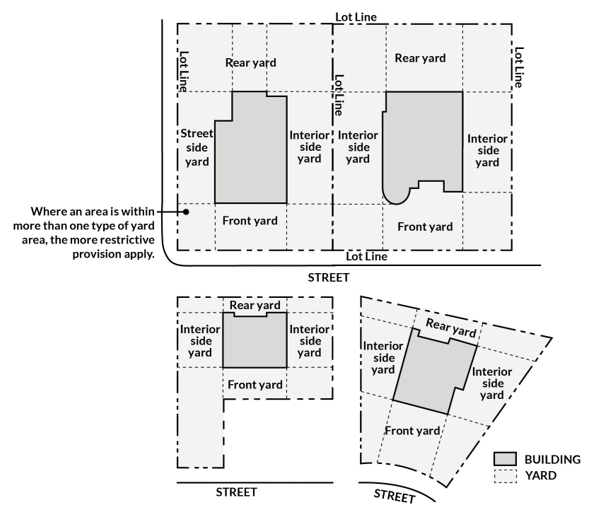
FIGURE 18.35.250.A: YARD TYPES
[Ord. 24-002 § 5 (Exh. A).]
18.35.260 “Z” terms.
“Zoning district” means a specifically delineated area in the City within which regulations and requirements uniformly govern the use, placement, spacing, and size of land and buildings. [Ord. 24-002 § 5 (Exh. A).]


